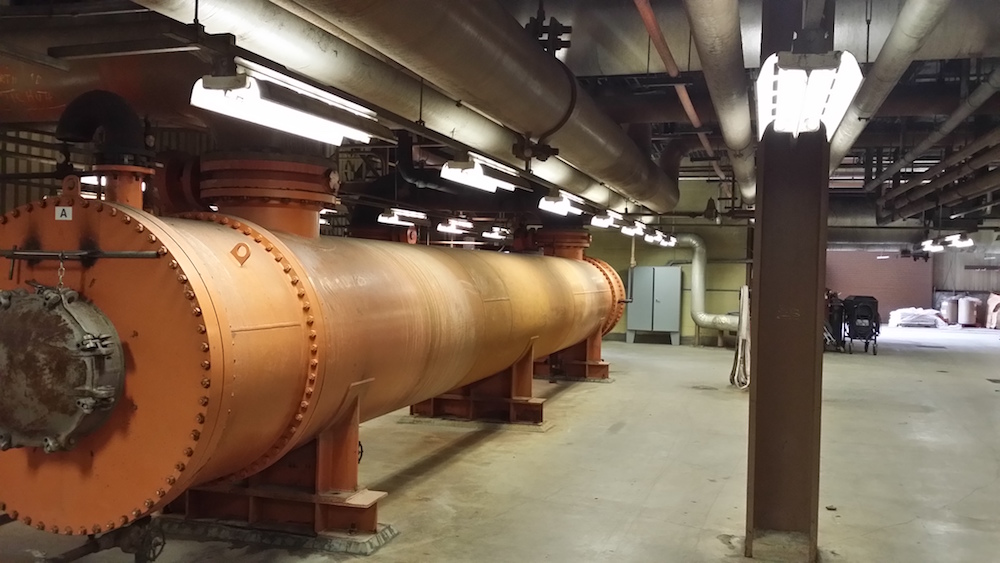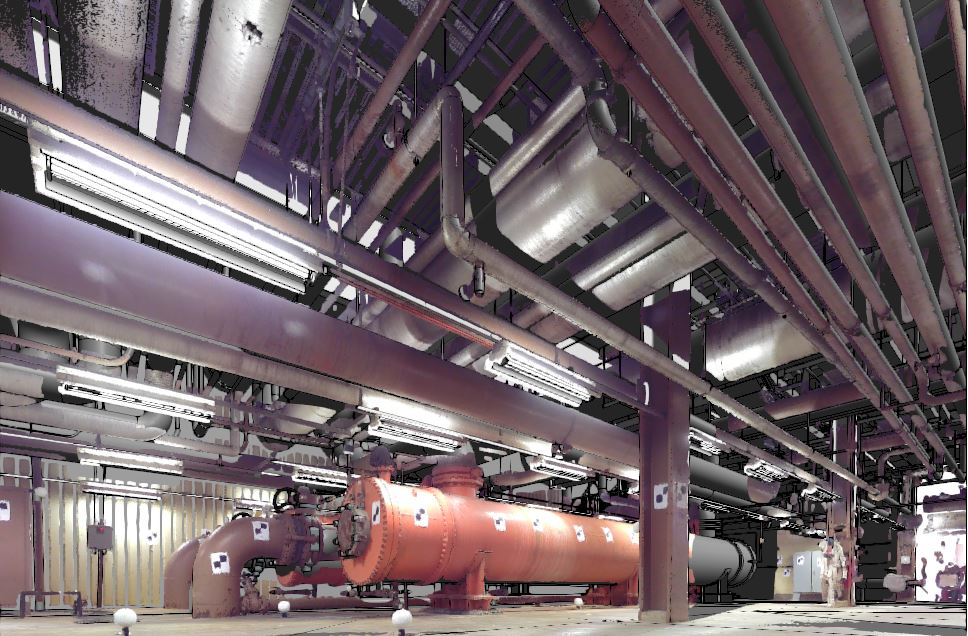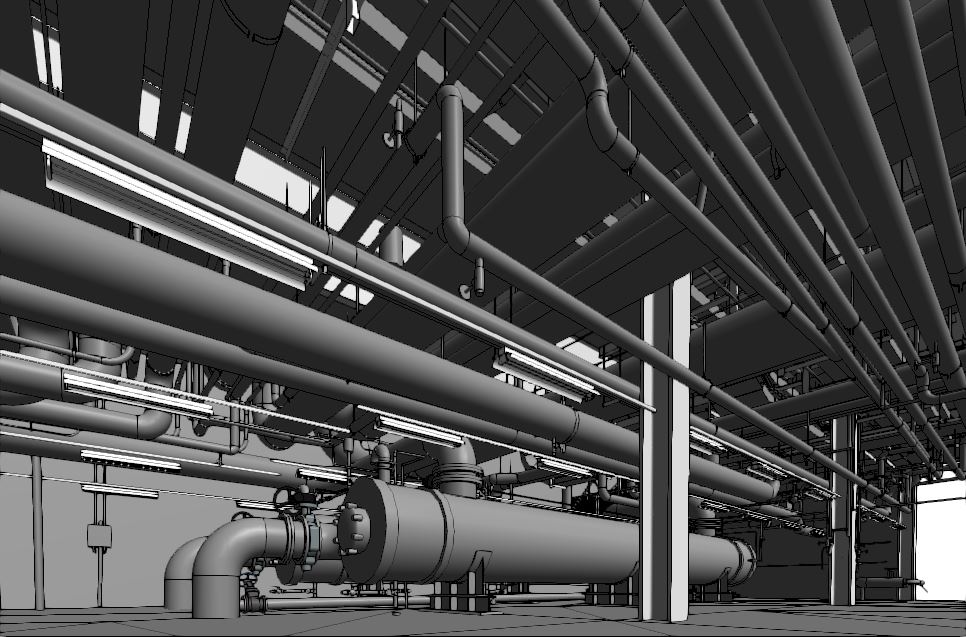When the power division of Black & Veatch needed to perform field measurement and modeling of the complex Iatan 1 Power Plant, located near Platte City, Missouri, they engaged Structural Modeling & Analysis (SMA), a Kansas City-based firm specializing in structural engineering design and analysis as well as laser scanning and modeling. SMA was brought in at the urging of Kansas City Power & Light Company (KCP&L) in order to save time and money while navigating the unique challenges created by a pipe-dense plant. The job entailed laser scanning the site to collect all the data, registering, making a model showing all the piping in Autodesk® Revit® and exporting it out in AutoCAD® to deliver results, enabling the safe and successful installation of a new heat exchanger.
Challenges
Black & Veatch, a large engineering, procurement and construction (EPC) company, understood the complexities of the 651-megawatt (MW) Iatan 1 Power Plant site, including the quantity and density of the piping as well as how little room for error existed due to all the piping connections required between the existing heat exchangers and the new one they wanted to install. Black & Veatch did not, however, have much experience in laser scanning, therefore, SMA Engineering was contracted to conduct the condition survey of the plant.
Due to the tremendously complex, pipe-dense space, the engineer’s plan initially budgeted six to eight weeks for field measurement and approximately 10 additional weeks for modeling the information from the field. In addition to the inordinate amount of time they were looking at, another concern was accuracy: trying to measure a space that was approximately 100 feet long by 50 feet wide, with two floor levels, three levels of cable trays and 2,000 pipes is a daunting task if using traditional methods such as tape measures and standard field measurement practice.
Safety and workflow at the power plant were among the other major challenges with this project. According to J Brown, P.E., S.E., Principal Engineer at SMA, “Given the multiple floors and dense piping, the safety of those performing the work would be of utmost concern. Utilizing traditional measuring methods, there would be little chance to safely access all the spaces required.” Another concern was how not to interrupt the workflow of the location, something that is critical at an active power plant.
Solutions
Time
With their expertise in utilizing laser scanner technology and modeling, the SMA team went into the space and performed a total of 93 scans using the FARO Focus3D X 330 Laser Scanner, in just 12 hours—a day and a half of work.
Prior to leaving the site, SMA began registering the scans and checking to confirm they had sufficient data to accurately model the cable tray, piping and equipment. In addition, they performed their confirmation process to back-check the scan data to the real world.
Brown explains the process further: “Once back in the office, the processing and registration was completed using SCENE, FARO’s 3D documentation software. At that point, the scan data was run through Autodesk® ReCap 360™ to create the files for use with Autodesk® Revit®. Then, we used Trimble EdgeWise to very rapidly convert the laser-scanned pipes into Revit® component pipes. We used EdgeWise to model the pipes and perform the rest of the modeling within Revit®, thereby extending the usefulness of the point cloud.”
While there was a fair amount of tweaking to account for some false positives, the software did an excellent job in terms of being able to get a very large amount of data switched over. This aspect of the job took another three weeks, followed by another two and a half weeks for cleanup, finishing, connecting pipe elbows, etc.
So, while Black & Veatch originally estimated spending six to eight weeks on field measuring alone, and an additional 10 weeks for modeling, SMA was able to accommodate a much shorter window. Mark Middleton, SMA’s Business Development Manager adds, “After the scanning, SMA modeled all of that piping—over 2,000 pipes, three levels of cable tray, two giant heat exchangers and a mezzanine level and ground level floor space. With the scanning technology in place, we were able to scan, register and model everything in only five and a half weeks total.”
Safety and Accessibility
Due to the portability of the scanner vs. a more traditional method, the risk factors on the job were minimized—for instance, the mobility to safely take the system up a set of stairs. On the second level, for example, the KCP&L team lifted a grate, allowing SMA to flip the scanner upside down, shoot it down into the hole and then shoot it all the way down the cable tray. Brown notes, “It would have been physically impossible, not to mention a huge safety issue, to actually climb out on those pipes. Therefore, using the scanner enabled us to access the 2,000 pipes, most of which we would not have been able to get to using traditional field measure protocols. We were able to scan the top surface and the underside because we were able to flip the laser scanner upside down.”
SMA was able to perform the work from ground level (either the floor or the mezzanine platform) instead of using a scissor lift or scaffolding—or just not being able to get the data at all.
Bottom line, laser scanning allowed the team to capture areas that would otherwise be too dangerous, impractical, or impossible to document with a tape measure or traditional methods of field measurements.
Accuracy
Being able to scan and collect data from both the top surface and underside allowed SMA to establish the pipes’ outer diameters with much greater accuracy since they essentially had access to the entire cross section. If they only had the bottom side, for instance, they would have just gotten portions and the software would have had a much harder time assigning pipe diameters. (Note: since most of the pipes were insulated, only the outer diameters could be measured.)
SMA was able to model the existing heat exchangers and showed the space available for the new exchanger. The model accurately located all of the pipes, cable tray, lighting, etc. that new lines for the new heat exchanger would have to be routed around and/or identified existing lines that would have to be re-routed.
Workflow
Using the eye-safe FARO Focus3D X 330 allowed SMA to work without endangering the employees or causing a disruption to the normal plant operation. J Brown notes, “The unobtrusive nature of the scanner resulted in no interruption to workflow, a critical factor for the functioning of a power plant. There was no need to section off any areas for the team. The plant was operating while they were working and there were adjacent KCP&L employees working in the area as well.”
Results
Deliverable
SMA modeled the site in Revit® and then exported it out in AutoCAD®, which is what the client required.
Time savings
The client estimated six to eight weeks of field measurements and 10 weeks of modeling to convert those measurements to the required AutoCAD® model. Creating an as-built condition survey with a laser scanner, a 16- to 18-week project was minimized to just over five weeks total, saving a total of 13 weeks from the worst-case projection.
Cost savings/ROI
The client charged approximately $180/hr x 2 people in field + 3 people doing design work. SMA estimates that they saved the project approximately $80,000 based on what they were initially told the field measurements and modeling would cost.
Conclusion
As stated on the SMA website, “When you consider the cost of sending a team to be on site for days or weeks to gather a few hundred to a thousand measurements using traditional methods—and compare it to being on site for a fraction of that time and picking up millions if not billions of measurements—the cost of laser scanning pays for itself.”
Related Stories
BIM and Information Technology | May 8, 2023
3 ways computational tools empower better decision-making
NBBJ explores three opportunities for the use of computational tools in urban planning projects.
Sustainability | May 1, 2023
Increased focus on sustainability is good for business and attracting employees
A recent study, 2023 State of Design & Make by software developer Autodesk, contains some interesting takeaways for the design and construction industry. Respondents to a survey of industry leaders from the architecture, engineering, construction, product design, manufacturing, and entertainment spheres strongly support the idea that improving their organization’s sustainability practices is good for business.
Sustainability | Apr 20, 2023
13 trends, technologies, and strategies to expect in 2023
Biophilic design, microgrids, and decarbonization—these are three of the trends, technologies, and strategies IMEG’s market and service leaders believe are poised to have a growing impact on the built environment.
Urban Planning | Apr 17, 2023
The future of the 20-minute city
Gensler's Stacey Olson breaks down the pros and cons of the "20-minute city," from equity concerns to data-driven design.
Intelligent Lighting | Feb 13, 2023
Exploring intelligent lighting usage in healthcare, commercial facilities
SSR's Todd Herrmann, PE, LEEP AP, explains intelligent lighting's potential use cases in healthcare facilities and more.
AEC Tech | Jan 27, 2023
Epic Games' latest foray into the AEC market and real estate industry
From architecture to real estate, the realm of computer-aided design hits new heights as more and more firms utilize the power of Epic Games’ Twinmotion and Unreal Engine.
AEC Tech | Jan 27, 2023
Key takeaways from Autodesk University 2022
Autodesk laid out its long-term vision to drive digital collaboration through cloud-based solutions and emphasized the importance of connecting people, processes and data.
Digital Twin | Nov 21, 2022
An inside look at the airport industry's plan to develop a digital twin guidebook
Zoë Fisher, AIA explores how design strategies are changing the way we deliver and design projects in the post-pandemic world.
BAS and Security | Oct 19, 2022
The biggest cybersecurity threats in commercial real estate, and how to mitigate them
Coleman Wolf, Senior Security Systems Consultant with global engineering firm ESD, outlines the top-three cybersecurity threats to commercial and institutional building owners and property managers, and offers advice on how to deter and defend against hackers.
Sponsored | BIM and Information Technology | Jul 19, 2022
Why Autodesk Tandem is the best fit for your projects



















